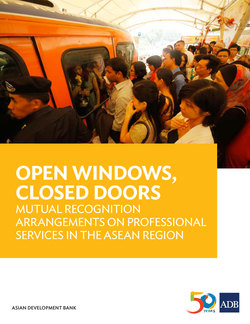Читать книгу Open Windows, Closed Doors - Guntur Sugiyarto - Страница 6
На сайте Литреса книга снята с продажи.
I. Introduction
ОглавлениеRecognition of professional and academic credentials on an individual and case-by-case basis using criteria set unilaterally by one country has long been the norm for ASEAN professionals wishing to practice across borders. Competent authorities at destination assess the qualifications that foreign professionals acquired in their country of origin and determine, according to unilaterally determined criteria, the level of equivalence. Many experts agree that unilateral recognition often leads to less than full recognition and, even more troubling, to arbitrary outcomes, since the discretionary character of the unilateral procedure does not ensure objectively predictable assessments.
Mutual recognition arrangements (MRAs), which allow for two or more parties (state or nonstate) to jointly create a reciprocal recognition process, ideally reduce the uncertainty related to recognition of qualifications and rights of professionals to practice. Parties to MRAs essentially renounce, in part or in full, the discretion of assessing qualifications unilaterally on a case-by-case basis. By jointly setting standardized rules for mutual recognition, MRAs potentially make it easier for professionals to have their qualifications recognized in another country.
Indeed, many countries worldwide have entered into MRAs in an effort to create a more predictable recognition process.3 The Association of Southeast Asian Nations (ASEAN) has followed this trend by signing MRAs in the tourism sector and in six regulated occupations—accountancy, architecture, dentistry, engineering, medicine, and nursing (see Table 1). Concluded over the span of 9 years, between 2003 and 2014, the ASEAN MRAs share nearly identical objectives but diverge significantly in terms of institutional structures, requirements, and procedures. Policymakers in the region are currently working toward an MRA in the surveying field, but this agreement is still in the framework stage. As a result, this report will focus on the structure of the seven MRAs that have been fully concluded and are at varying stages of implementation.
Table 1: ASEAN Mutual Recognition Arrangements
| ASEAN Mutual Recognition Arrangement | Date of signing |
|---|---|
| Engineering Services | 9 December 2005 |
| Nursing Services | 8 December 2006 |
| Architectural Services | 19 November 2007 |
| Dental Practitioners | 26 February 2009 |
| Medical Practitioners | 26 February 2009 |
| Tourism Professionals | 9 November 2012 |
| Accountancy Services | 13 November 2014 |
This report aims to compare the different approaches ASEAN Member States have taken to facilitate mutual recognition of qualifications within the region, the factors that shaped each MRA approach, and their tradeoffs and policy implications. More specifically, the report aims to answer questions regarding:
1.Different MRA approaches. How do the ASEAN MRAs differ from each other and in what ways are they alike? Which MRA frameworks are the most and least open for foreign professionals if measured along five dimensions: the automaticity of the recognition process, the level of delegation of authority away from the country of destination, the scope of MRA coverage, the level of institutionalization, and the strength of post-MRA guarantees?
2.Evolution of the ASEAN MRAs. What factors have contributed to the design of each MRA approach? To what extent does the creation of the ASEAN Economic Community (AEC)4 and the huge diversity in the region shape the different MRA designs?
3.Tradeoffs and their policy implications. What are the costs and benefits of the different approaches and their policy implications in the short and medium term?
4.Looking into the future. How can the region maximize the potential of MRAs in building and utilizing human capital in the long term? Are there opportunities to create synergies with related developments such as the ASEAN Qualification Regional Framework (AQRF)5 and existing mobility arrangements in the region? Are the approaches and practices adopted in the current ASEAN MRAs replicable in other sectors and occupations—or are they specific to each industry or regulatory body?
In exploring these issues, the Asian Development Bank (ADB) and Migration Policy Institute (MPI) consulted with 387 regional and international experts on mutual recognition and professional mobility. ADB and MPI researchers convened 12 days of focus group discussions and meetings between May and September 2015 that were attended by more than 100 MRA stakeholders and experts, including a former ASEAN Secretary-General, the Chair of the ASEAN Business Council, and officials from key ministries engaged in MRA development across the region. ADB and MPI researchers also administered a qualitative survey to examine MRA implementation that was completed by 311 individuals from relevant government ministries, the private sector, professional associations, educational institutions, and the human resources field. Appendices 2 and 3 list the affiliations of all stakeholders who attended the meetings and completed the MRA implementation survey.
This report begins by comparing the ASEAN MRAs along five key dimensions—the automaticity of the recognition process, the level of delegation of authority away from the country of destination, the scope and depth of MRA coverage, the degree of institutionalization, and the strength of post-MRA guarantees. Section III offers a typology of different approaches ASEAN Member States have taken; Sections IV and V identify the various factors that shaped each approach, their tradeoffs, and corresponding policy implications. The report ends by outlining potential areas for cooperation that can maximize the potential of MRAs as tools for building and utilizing human capital in the region.6
